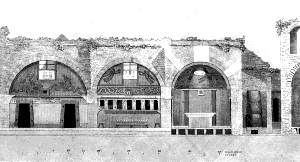Plate XXV - Section of the thermae
|
This section is given immediately after the view to
render it more intelligible. |
The tepidarium seems to have been warmed only by
the large foculare given by Vaccula, having his
symbol, the cow, of bronze, in the centre.
The caldarium, with its orifices or vents for the
escape of vapour, is the arch on the right, and its pavement
is suspended in such a manner that the heated air from the
furnace is enabled to warm it in every part.
A black line, rising from this hypocaust, represents a cavity
in the masonry by which the lateral walls of the chamber are
heated.
To the right of this is the furnace, and, above it, was a
brazen caldron, the form of which might be learned from the
bed of mortar which had enclosed it.
This caldron was called also the caldarium, that above
it the tepidarium, and the uppermost the
frigidarium ; and they were so contrived, by means of
something of the nature of a syphon, that, when the water of
the lowest was drawn off for the bath, an equal quantity
descended simultaneously from the second to the lowest
caldron, and from the uppermost to the second, while the
reservoir discharged itself into the
frigidarium.
The remainder of the building to the right would have been
only a repetition of the foregoing description, and is
therefore omitted, as its insertion would have too much
diminished the size of each portion of the section.
From the form in which the cement remains in which the brazen
caldrons were embedded, there can be little doubt that they
were placed in the manner here represented. There may,
however, have been more than one set of these vases, and,
possibly, there might have been three, placed one behind the
other, where the ruin is somewhat confused. One of these sets
of vases might have been appropriated to the uses of the
labrum.
